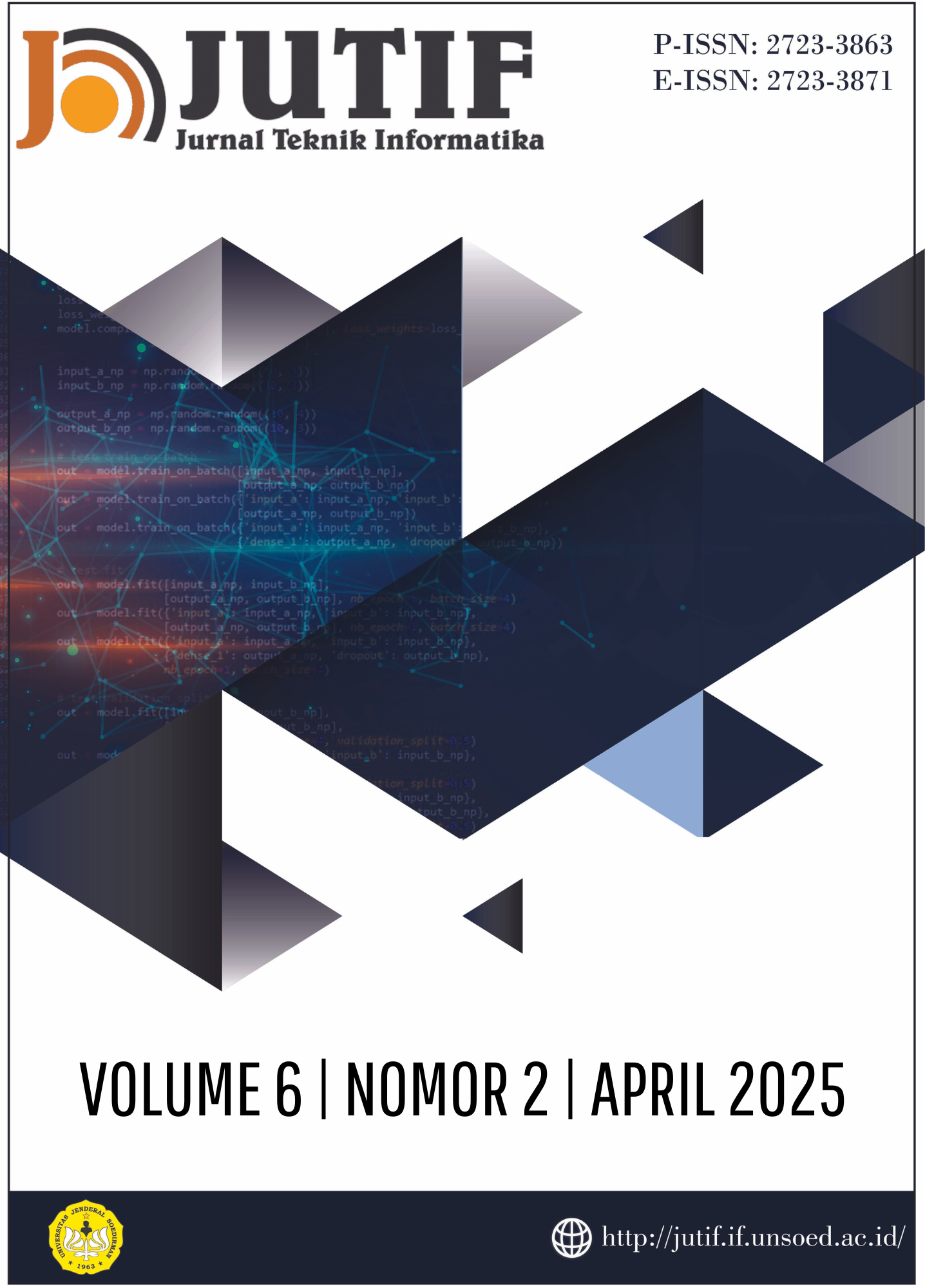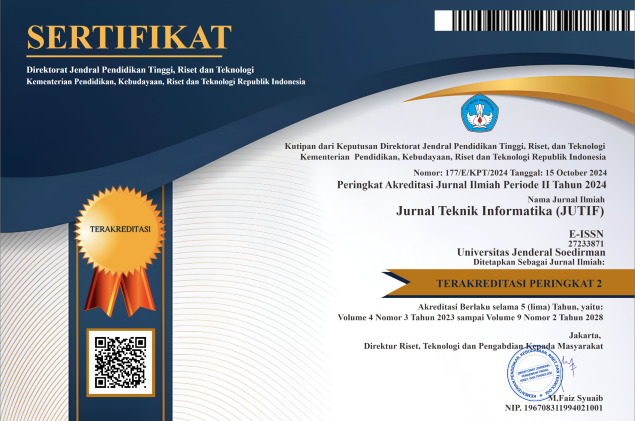Geo-Sentiment Analysis of Public Opinion of X Users towards the Documentary Film Dirty Vote using the Bidirectional Long Short-Term Memory Method
DOI:
https://doi.org/10.52436/1.jutif.2025.6.2.4195Keywords:
Bi-LSTM, Class Weight, Dirty Vote, FastText, Geo-sentiment analysis, SMOTE, TF-IDFAbstract
Presidential elections held every five years, often generates significant public discourse. The 2024 presidential election saw the release of the documentary Dirty Vote, which raised allegations of electoral fraud and sparked polarized opinions on social media, especially on X. This study aims to analyze public sentiment toward Dirty Vote using geo-sentiment analysis and the Bidirectional Long Short-Term Memory (Bi-LSTM) model. Data were collected from geotagged tweets, with sentiment classified as positive, negative, or neutral. The research explored various data processing techniques, including TF-IDF for feature extraction, FastText for feature expansion, and balancing methods like SMOTE and class weighting to address data imbalance. Results showed that the baseline Bi-LSTM model achieved an accuracy of 71.57% and an F1-Score of 74.05%. When enhanced with TF-IDF and FastText, accuracy increased to 77.07%, though the F1-Score dropped slightly to 72.95%. Applying SMOTE resulted in a decrease in accuracy to 76.45%, but significantly improved the F1-Score to 74.93%. Exploratory data analysis revealed that negative sentiment was most concentrated in Java Island, particularly Jakarta, and peaked during February 2024, coinciding with the documentary's release and the election period. This study significantly contributes to understanding how geographic locations influence public opinion on sensitive political issues. A lack of understanding of geographically-based sentiment patterns can hinder identifying regional needs, leading to poorly targeted policies. By integrating data analysis methods with geographical approaches, this research provides deep insights for designing more effective, data-driven public intervention strategies and supports policymaking that is more responsive to the dynamics of public opinion.
Downloads
References
F. Esfandiari and N. Hidayah, “General Elections in Indonesia : Between Human Rights and Constitutional Rights,” European Alliance for Innovation n.o., Feb. 2021. doi: 10.4108/eai.1-7- 2020.2303622.
Inayatulloh, I. K. Hartono, and D. L. Kusumastuti, “The Blockchain Conceptual Model to Prevents Fraud and Increase Transparency in the Presidential Election in Indonesia,” 2023 IEEE 9th International Conference on Computing, Engineering and Design, ICCED 2023, 2023, doi: 10.1109/ICCED60214.2023.10425635.
K. Kurnia, “Measuring the Concept of Deliberative Democracy in the Indonesian Election Supervision System,” Dec. 2020, doi: 10.4108/EAI.26-9-2020.2302602.
F. Agung, J. Ayomi, and K. E. Dewi, “Analisis Emosi pada Media Sosial Twitter Menggunakan Metode Multinomial Naive Bayes dan Synthetic Minority Oversampling Technique,” Komputa : Jurnal Ilmiah Komputer dan Informatika, vol. 12, no. 2, pp. 9–19, Sep. 2023, doi: 10.34010/KOMPUTA.V12I2.9454.
R. DAHIYA, A. Dhankhar, and A. DHANKHAR, “Sentimental Analysis Of Social Networks :A Comprehensive review(2018-2023),” Nov. 20, 2023. doi: 10.21203/rs.3.rs- 3625172/v1.
D. F. Putra and Y. Sibaroni, “Sentiment Analysis For The 2024 Presidential Election (Pilpres) Using BERT CNN,” Eduvest - Journal of Universal Studies, vol. 4, no. 11, pp. 11042–11056, Nov. 2024, doi: 10.59188/EDUVEST.V4I11.49961.
L. Chaudhary, N. Girdhar, D. Sharma, J. Andreu-Perez, A. Doucet, and M. Renz, “A Review of Deep Learning Models for Twitter Sentiment Analysis: Challenges and Opportunities,” IEEE Trans Comput Soc Syst, vol. 11, no. 3, pp. 3550–3579, Jun. 2024, doi: 10.1109/TCSS.2023.3322002.
R. Cahyani, I. S. Rozas, and N. Yalina, “Analisis Sentimen Pada Media Sosial Twitter Terhadap Tokoh Publik Peserta Pilpres 2019,” MATICS: Jurnal Ilmu Komputer dan Teknologi Informasi (Journal of Computer Science and Information Technology), vol. 12, no. 1, pp. 79– 86, Apr. 2020, doi: 10.18860/MAT.V12I1.8356.
R. F. Ananda, A. Syahri, and F. N. Hasan, “SENTIMENT ANALYSIS OF CUSTOMER SATISFACTION IN GOJEK AND GRAB APPLICATION REVIEWS USING THE NAIVE
BAYES ALGORITHM,” Jurnal Teknik Informatika (Jutif), vol. 5, no. 1, pp. 233–241, Feb. 2024, doi: 10.52436/1.JUTIF.2024.5.1.1680.
G. Radiena and A. Nugroho, “ANALISIS SENTIMEN BERBASIS ASPEK PADA ULASAN APLIKASI KAI ACCESS MENGGUNAKAN METODE SUPPORT VECTOR MACHINE,”
Jurnal Pendidikan Teknologi Informasi (JUKANTI), vol. 6, no. 1, pp. 1–10, Apr. 2023, doi: 10.37792/JUKANTI.V6I1.836.
I. Sinanto Ate, A. Nuraminah, and P. Studi, “Komparasi Algoritma Feature Selection Pada Analisis Sentimen Review Film,” Jurnal Ilmiah Teknik Informatika dan Komunikasi, vol. 2, no. 2, pp. 96–102, Jul. 2022, doi: 10.55606/JUITIK.V2I2.326.
S. Puad, G. Garno, and A. S. Y. Irawan, “ANALISIS SENTIMEN MASYARAKAT PADA TWITTER TERHADAP PEMILIHAN UMUM 2024 MENGGUNAKAN ALGORITMA
NAÏVE BAYES,” JATI (Jurnal Mahasiswa Teknik Informatika), vol. 7, no. 3, pp. 1560–1566, Oct. 2023, doi: 10.36040/JATI.V7I3.6920.
A. Raup, W. Ridwan, Y. Khoeriyah, S. Supiana, and Q. Y. Zaqiah, “Deep Learning dan Penerapannya dalam Pembelajaran,” JIIP - Jurnal Ilmiah Ilmu Pendidikan, vol. 5, no. 9, pp. 3258–3267, Sep. 2022, doi: 10.54371/JIIP.V5I9.805.
Sudianto, P. Wahyuningtias, H. W. Utami, U. A. Raihan, H. N. Hanifah, and Y. N. Adanson, “COMPARISON OF RANDOM FOREST AND SUPPORT VECTOR MACHINE METHODS ON TWITTER SENTIMENT ANALYSIS (CASE STUDY: INTERNET SELEBGRAM RACHEL VENNYA ESCAPE FROM QUARANTINE),” Jurnal Teknik
Informatika (Jutif), vol. 3, no. 1, pp. 141–145, Feb. 2022, doi: 10.20884/1.JUTIF.2022.3.1.168.
L. Xiaoyan and R. C. Raga, “BiLSTM Model With Attention Mechanism for Sentiment Classification on Chinese Mixed Text Comments,” IEEE Access, vol. 11, pp. 26199–26210, 2023, doi: 10.1109/ACCESS.2023.3255990.
A. I. Safitri and T. B. Sasongko, “SENTIMENT ANALYSIS OF CYBERBULLYING USING BIDIRECTIONAL LONG SHORT TERM MEMORY ALGORITHM ON TWITTER,” Jurnal
Teknik Informatika (Jutif), vol. 5, no. 2, pp. 615–620, Apr. 2024, doi: 10.52436/1.JUTIF.2024.5.2.1922.
E. Subowo, F. A. Artanto, I. Putri, and W. Umaedi, “Algoritma Bidirectional Long Short Term Memory untuk Analisis Sentimen Berbasis Aspek pada Aplikasi Belanja Online dengan Cicilan,” JURNAL FASILKOM, vol. 12, no. 2, pp. 132–140, Aug. 2022, doi: 10.37859/JF.V12I2.3759.
A. Muzakir and U. Suriani, “Model Deteksi Berita Palsu Menggunakan Pendekatan Bidirectional Long Short-Term Memory (BiLSTM),” Journal of Computer and Information Systems Ampera, vol. 4, no. 2, 2023, doi: 10.51519/journalcisa.v4i2.397.
H. Akbar, D. Aryani, M. Kadhim, M. Al-Shammari, and M. B. Ulum, “SENTIMENT ANALYSIS FOR E-COMMERCE PRODUCT REVIEWS BASED ON FEATURE FUSION
AND BIDIRECTIONAL LONG SHORT-TERM MEMORY,” Jurnal Teknik Informatika (Jutif), vol. 5, no. 5, pp. 1385–1391, Oct. 2024, doi: 10.52436/1.JUTIF.2024.5.5.2675.
Fuad Amirullah, Syariful Alam, and M.Imam Sulistyo S, “Analisis Sentimen Terhadap Kinerja KPU Menjelang Pemilu 2024 Berdasarkan Opini Twitter Menggunakan Naïve Bayes,” STORAGE: Jurnal Ilmiah Teknik dan Ilmu Komputer, vol. 2, no. 3, pp. 69–76, Aug. 2023, doi: 10.55123/STORAGE.V2I3.2293.
A. Almaslukh, A. Almaalwy, N. Allheeib, A. Alajaji, M. Almukaynizi, and Y. Alabdulkarim, “Top-k sentiment analysis over spatio-temporal data,” PeerJ Comput Sci, vol. 10, p. e2297, Sep. 2024, doi: 10.7717/PEERJ-CS.2297/FIG-5.
Z. Gong, T. Cai, J. C. Thill, S. Hale, and M. Graham, “Measuring relative opinion from location-based social media: A case study of the 2016 U.S. presidential election,” PLoS One, vol. 15, no. 5, p. e0233660, May 2020, doi: 10.1371/JOURNAL.PONE.0233660.
D. Tas and R. P. Sanatani, “Geo-located Aspect Based Sentiment Analysis (ABSA) for Crowdsourced Evaluation of Urban Environments,” arXiv preprint, Dec. 2023, Accessed: Jan. 05, 2025. [Online]. Available: https://www.alphaxiv.org/abs/2312.12253v1
A. Mushofy Anwary, A. ID Hadiana, and P. Nurul Sabrina, “ANALISIS SENTIMENT PENGGUNAAN VAKSIN COVID-19 MENGGUNAKAN GEO-TAGGED TWEETS DAN
ALGORITMA NAIVE BAYES,” Informatics and Digital Expert (INDEX), vol. 3, no. 2, pp. 75–83, Nov. 2021, doi: 10.36423/INDEX.V3I2.876.
T. Hu, B. She, L. Duan, H. Yue, and J. Clunis, “A systematic spatial and temporal sentiment analysis on geo-tweets,” IEEE Access, vol. 8, pp. 8658–8667, 2020, doi: 10.1109/ACCESS.2019.2961100.
E. Veltmeijer and C. Gerritsen, “SentiMap: Domain-Adaptive Geo-Spatial Sentiment Analysis,” Proceedings - 17th IEEE International Conference on Semantic Computing, ICSC 2023, pp. 17–24, 2023, doi: 10.1109/ICSC56153.2023.00010.
I. F. Ramadhy and Y. Sibaroni, “Analisis Trending Topik Twitter dengan Fitur Ekspansi FastText Menggunakan Metode Logistic Regression,” JURIKOM (Jurnal Riset Komputer), vol. 9, no. 1, p. 1, Feb. 2022, doi: 10.30865/jurikom.v9i1.3791.
N. Silalahi, J. Josh, and G. Leonarde Ginting, “Analisa Sentimen Masyarakat Dalam Penggunaan Vaksin Sinovac Dengan Menerapkan Algoritma Term Frequence – Inverse Document Frequence (TF-IDF) dan Metode Deskripsi,” Journal of Information System Research (JOSH), vol. 3, no. 3, pp. 206–217, Apr. 2022, doi: 10.47065/JOSH.V3I3.1441.
K. Pamungkas, K. T. Pamungkas, L. Aridinanti, and W. Wibowo, “Analisis Sentimen Pelaporan Masyarakat di Situs Media Centre Surabaya dengan Naïve Bayes Classifier,” Jurnal Sains dan Seni ITS, vol. 11, no. 2, pp. D197–D203, Jul. 2022, doi: 10.12962/j23373520.v11i2.72566.
M. Das, S. Kamalanathan, and P. Alphonse, “A Comparative Study on TF-IDF feature Weighting Method and its Analysis using Unstructured Dataset,” CEUR Workshop Proc, vol. 2870, pp. 98–107, Aug. 2023, doi: 10.48550/arXiv.2308.04037.
M. F. D. Putra and E. B. Setiawan, “Influence of Sentiment on Mandiri Bank Stocks (BMRI) Using Feature Expansion with FastText and Logistic Regression Classification,” ICACNIS 2022 - 2022 International Conference on Advanced Creative Networks and Intelligent Systems: Blockchain Technology, Intelligent Systems, and the Applications for Human Life, Proceeding, 2022, doi: 10.1109/ICACNIS57039.2022.10055450.
M. Liebenlito, A. A. Yesinta, and M. I. S. Musti, “Deteksi Clickbait pada Judul Berita Online Berbahasa Indonesia Menggunakan FastText,” Journal of Applied Computer Science and Technology, vol. 5, no. 1, pp. 56–62, Mar. 2024, doi: 10.52158/jacost.v5i1.655.
M. Rahman, M. D. Rahman, A. Djunaidy, and F. Mahananto, “Penerapan Weighted Word Embedding pada Pengklasifikasian Teks Berbasis Recurrent Neural Network untuk Layanan Pengaduan Perusahaan Transportasi,” Jurnal Sains dan Seni ITS, vol. 10, no. 1, pp. A1–A6, Aug. 2021, doi: 10.12962/j23373520.v10i1.56145.
B. G. Marcot and A. M. Hanea, “What is an optimal value of k in k-fold cross-validation in discrete Bayesian network analysis?,” Comput Stat, vol. 36, no. 3, pp. 2009–2031, Sep. 2021, doi: 10.1007/S00180-020-00999-9/METRICS.
M. Jaiswal, H. Tiwari, and S. Kumar, “Diabetes Prediction using Optimization Techniques with Machine Learning Algorithms,” Int J Electron Healthc, vol. 13, no. 1, p. 1, 2023, doi: 10.1504/ijeh.2023.10054229.
D. I. Puteri, “Implementasi Long Short Term Memory (LSTM) dan Bidirectional Long Short Term Memory (BiLSTM) Dalam Prediksi Harga Saham Syariah,” Euler : Jurnal Ilmiah Matematika, Sains dan Teknologi, vol. 11, no. 1, pp. 35–43, May 2023, doi: 10.34312/euler.v11i1.19791.
R. Annas Sholehat, E. B. Setiawan, and Y. Sibaroni, “Aspect-Based Sentiment Analysis on Twitter Using Bidirectional Long Short-Term Memory,” JURNAL MEDIA INFORMATIKA BUDIDARMA , vol. 7, pp. 999–999, 2023, doi: 10.30865/mib.v5i1.2293.
E. Erlin, Y. Desnelita, N. Nasution, L. Suryati, and F. Zoromi, “Dampak SMOTE terhadap Kinerja Random Forest Classifier berdasarkan Data Tidak seimbang,” MATRIK : Jurnal Manajemen, Teknik Informatika dan Rekayasa Komputer, vol. 21, no. 3, pp. 677–690, Jul. 2022, doi: 10.30812/MATRIK.V21I3.1726.
T. Wongvorachan, S. He, and O. Bulut, “A Comparison of Undersampling, Oversampling, and SMOTE Methods for Dealing with Imbalanced Classification in Educational Data Mining,” Information (Switzerland), vol. 14, no. 1, Jan. 2023, doi: 10.3390/info14010054.
E. Sutoyo and M. A. Fadlurrahman, “Penerapan SMOTE untuk Mengatasi Imbalance Class dalam Klasifikasi Television Advertisement Performance Rating Menggunakan Artificial Neural Network,” Jurnal Edukasi dan Penelitian Informatika (JEPIN), vol. 6, no. 3, p. 379, Dec. 2020, doi: 10.26418/JP.V6I3.42896.
D. Elreedy, A. F. Atiya, and F. Kamalov, “A theoretical distribution analysis of synthetic minority oversampling technique (SMOTE) for imbalanced learning,” Mach Learn, vol. 113, no. 7, pp. 4903–4923, Jul. 2024, doi: 10.1007/s10994-022-06296-4.
H. Akbar and W. K. Sanjaya, “Kajian Performa Metode Class Weight Random Forest pada Klasifikasi Imbalance Data Kelas Curah Hujan,” Jurnal Sains, Nalar, dan Aplikasi Teknologi Informasi, vol. 3, no. 1, Dec. 2023, doi: 10.20885/SNATI.V3I1.30.
Additional Files
Published
How to Cite
Issue
Section
License
Copyright (c) 2025 Syifa Salsabila, Yuliant Sibaroni, Sri Suryani Prasetiyowati

This work is licensed under a Creative Commons Attribution 4.0 International License.



























